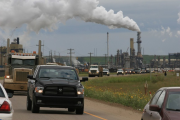Thousands of Americans — many of them high-profile, law-abiding citizens — will be risking arrest over the coming weeks to send a message to their president about importing oil from Canada's oilsands: "Just say no."
It's a familiar slogan in the U.S., thanks to the controversial and decades-long "War on Drugs". But the Americans taking part in a historic sit-in at the White House are fighting to help their country break a different kind of addiction — a dependence on costly energy from Canadian oilsands, which carries a high price in terms of both the economics of extraction and the environmental impacts.
A growing unease with the oilsands
Those costs are intertwined, and will largely determine the future growth of the oilsands. They will shape the contribution of the oilsands to future global energy demand, affecting Canada's ability to sell oilsands to foreign markets such as the U.S., where many customers are growing increasingly uncomfortable with two factors: the rapid increase in greenhouse gas emissions, and the regional environmental impacts of oilsands development.
Let's take a closer look at the first factor by examining the oilsands industry's forecasted production. In 2010, oilsands production stood at 1.5 million barrels per day, but this number will more than double when projects that are under construction and with those future projects already approved by government regulators. Furthermore, production will skyrocket to around seven million barrels per day when factoring in disclosed projects and those already in the regulatory queue. These numbers paint a troubling picture of both growing greenhouse gas pollution and expanding environmental impacts.
The International Energy Agency (IEA) forecasts Canadian oilsands production under a few different scenarios as a part of their annual World Energy Outlook. Under the IEA's "450 scenario" (a scenario that attempts to avoid the worst impacts of climate change), Canadian oilsands production would reach only around three million barrels per day by 2035. This growth depends on the introduction of new technologies and policies that will reduce the emissions intensity of the industry.
Another IEA scenario assumes that recent commitments to address climate change are not acted upon (i.e. business as usual) and therefore includes considerable growth in oilsands production. But this scenario would result in "massive climatic change and irreparable damage to the planet." It is clear that this level of oilsands growth is both risky and irresponsible.
In other words, significantly increasing oilsands production is only possible in a world where little progress is made to prevent worsening climate change.
While the greenhouse gas pollution associated with oilsands development receives a lot of attention, there are certainly other environmental factors that are likely to constrain oilsands development.
Take Alberta's woodland caribou for example — a threatened species that requires protection under Canadian law. Virtually all threatened woodland caribou herds in Alberta are in decline as a result of too much development within their ranges. Canada's environment minister has noted that Alberta has been ineffective at protecting caribou and managing the cumulative effects of development, and a recent court decision requires the federal government to table its caribou recovery plan (now four years overdue) by the end of this month.
For that plan to be effective, it will need to place serious limits on the pace and scale of future oilsands development. Pressure is increasing to enforce similar limits to protect water quality and quantity, and many of Canada's First Nations are using legal means to argue that oilsands development must be moderated to respect their Treaty Rights to hunt, trap and fish on their traditional lands.
Governments must live up to their obligations
Such limits could well mean that future growth is far less than projected, barring significant technological breakthroughs. However, there are solutions to at least some of the unresolved impacts of oilsands development, and a large part of the Pembina Institute's work on oilsands environmental policy has focused on identifying the tools available to policy makers and oilsands companies.
The oilsands protests in the U.S. are evidence that Americans — and Canadians too — expect their governments to live up to their obligations to reduce greenhouse gas pollution and prevent environmental degradation.
As another banner at the U.S. protest reads, "Climate change is not in our national interest." That statement is equally true on this side of the border.
The Pembina Institute outlines 19 policy solutions to address environmental problems related to oilsands development in the recent report Solving the Puzzle: Environmental Responsibility in oilsands development (available online at http://www.pembina.org/pub/2210).






